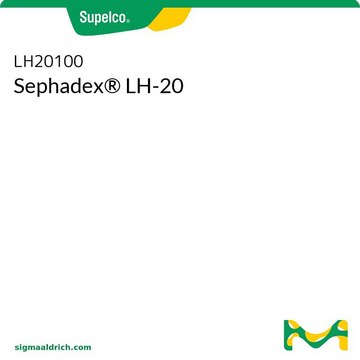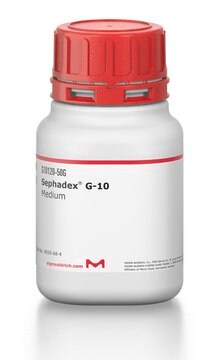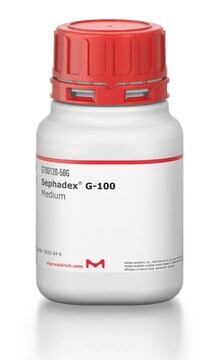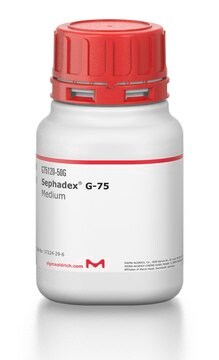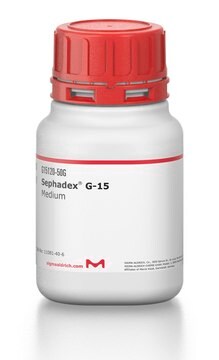G25150
Sephadex® G-25
Medium
Synonym(s):
Sephadex G-25 Medium, Sephadex® G-25 resins, Size exclusion resins
Sign Into View Organizational & Contract Pricing
All Photos(2)
About This Item
Recommended Products
Quality Level
technique(s)
buffer exchange: suitable
matrix active group
phase
swelling
1 g swells to 4-6 mL
bead size
50-150 μm
application(s)
life science and biopharma
compatibility
Cytiva
InChI
1S/C6H12O6.C3H8O3/c7-1-2-3(8)4(9)5(10)6(11)12-2;4-1-3(6)2-5/h2-11H,1H2;3-6H,1-2H2/t2-,3-,4-,5-,6-;/m1./s1
InChI key
BCPVZFFJGCURNR-OCOFDJSDSA-N
Looking for similar products? Visit Product Comparison Guide
General description
Sephadex® G-25 Medium is a size exclusion chromatography or gel filtration resin that is created by crosslinking dextran with epichlorohydrin. The various types of Sephadex can differ in their degree of cross-linking, resulting in variances in their swelling capacity and molecular fractionation range. Sephadex G-25 is one option available among the different G-types of Sephadex. Sephadex G-25 belongs to a range of five G-types, catering to different molecule sizes. Specifically, G-10 is suitable for small molecules, while G-75 is designed to accommodate larger molecules. Sephadex G-25 provides industrial requirements by ensuring a dependable supply and offering extensive technical and regulatory assistance.
Application
Fractionation Range (MW)
Dextrans: 100 - 5,000
Globular Proteins 1,000 - 5,000
Sephadex® G-25 has been used:
Dextrans: 100 - 5,000
Globular Proteins 1,000 - 5,000
Sephadex® G-25 has been used:
- in the desalting of protease
- in the column for the separation of radioiodinated oTP-1 from free iodine during the characterization of radioiodinated oTP-1 and receptor assay validation
Sephadex® G-25 has been used to separate the labelled proteins from unreacted dye N-hydroxysuccinimide (NHS) esters by gel permeation chromatography.
Biochem/physiol Actions
Sephadex® G-25 is a well-established gel filtration resin, widely used for desalting and buffer exchange in industrial applications. Its hydrophilic matrix minimizes nonspecific adsorption, resulting in high recoveries during these processes for proteins and nucleic acids. Sephadex® G-25 is usually used in affinity chromatography, protein chromatography and gel filtration chromatography.
Features and Benefits
- Rapid desalting, contaminant removal, and transfer to a new buffer in a single step.
- High recovery rate with minimal sample dilution.
- Offered in prepacked HiPrep Desalting and HiTrap desalting columns for convenient and fast desalting.
- Specifically designed as a BioProcess resin for industrial applications.
Legal Information
Sephadex is a registered trademark of Cytiva
replaced by
Storage Class Code
11 - Combustible Solids
WGK
WGK 3
Flash Point(F)
Not applicable
Flash Point(C)
Not applicable
Personal Protective Equipment
dust mask type N95 (US), Eyeshields, Gloves
Choose from one of the most recent versions:
Already Own This Product?
Find documentation for the products that you have recently purchased in the Document Library.
K M Yocom et al.
Proceedings of the National Academy of Sciences of the United States of America, 79(22), 7052-7055 (1982-11-01)
A stable complex between pentaammineruthenium(III) and histidine-33 in horse heart ferricytochrome c is formed in the reaction between aquopentaammineruthenium(II) and the protein at pH 7. HPLC of the tryptic hydrolysate of the modified protein was employed to identify the pentaammineruthenium
L R Hale et al.
Genetics, 129(1), 103-117 (1991-09-01)
Preliminary studies with restriction fragment length polymorphisms of mitochondrial DNA (mtDNA) in natural populations of Drosophila melanogaster revealed considerable variation in terms of nucleotide sequence and overall size. In this report we present data from more isofemale lines and more
David R Halpin et al.
PLoS biology, 2(7), E173-E173 (2004-06-29)
Recently reported technologies for DNA-directed organic synthesis and for DNA computing rely on routing DNA populations through complex networks. The reduction of these ideas to practice has been limited by a lack of practical experimental tools. Here we describe a
J J Knickerbocker et al.
Biology of reproduction, 40(2), 361-369 (1989-02-01)
Scatchard analysis was used to determine the distribution, number, and affinity of unoccupied receptors for ovine trophoblast protein-1 (oTP-1) in endometrium of sheep throughout the estrous cycle and early pregnancy. In Experiment I, oTP-1 receptor characteristics were determined in membrane
Characterization of endometrial receptors for ovine trophoblast protein-1 during the estrous cycle and early pregnancy in sheep
Knickerbocker JJ and Niswender GD
Biology of Reproduction, 40(2), 361-369 (1989)
Our team of scientists has experience in all areas of research including Life Science, Material Science, Chemical Synthesis, Chromatography, Analytical and many others.
Contact Technical Service
